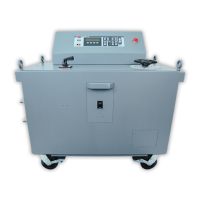5. MAINTENANCE OF LOW VOLTAGE POWER CIRCUIT BREAKERS
APPLICATION:
The low voltage power circuit breaker has a wide application and
may
be used to
protect circuits up to
600 volts ac
or
250 volts dc. These devices have essentially two
separate elements.
One element is a set
of
contacts with suitable mechanical linkage
for operating the breaker as a switch. The other element
is
a device to sense and react
to an overload or short circuit condition. Low voltage power circuit breakers are
manufactured with either electro-mechanical or solid state trip devices.
1.
SOLID STATE TRIP ELEMENTS - This type
of
breaker uses a sample
of
the load
current to supply a signal to an electronic sensing element.
When
an overload or
short circuit condition exists, the solid state sensing element sends a signal to a
solenoid which releases the latching mechanism and trips the circuit breaker. This
type eliminates the magnetic coil and dashpot mechanism
of
the electro-mechanical
trip device.
2. ELECTRO-MECHANICAL
TRIP ELEMENTS - Series tripped, direct acting low
voltage power circuit breakers are tripped by the movement
of
an armature which
strikes the trip bar
of
the breaker. The trip bar operates a latch which releases
stored energy to rapidly open the breaker contacts. The armature
of
the trip unit
is
attracted to a pole piece through the magnetic field set up by current through a coil.
The current through the coil is either the actual load current
or
the secondary output
of
a current transformer. For time delay the armature is restrained mechanically.
Tripping time is a function
of
magnitude
of
current through the breaker.
Low Voltage
Power Circuit Breakers are available with three types
of
tripping
characteristics:
1.
LONG TIME DELAY - The long time delay characteristic provides overload
protection with typical time delays
of
approximately 10 -60 seconds at 300%
of
pickup.
2.
SHORT TIME DELAY - The short time delay characteristic provides protection for
short circuit
or
fault conditions. It is used whenever a small delay is necessary for
coordination
or
selectivity with other protective devices. Typical delays are
approximately
6-30 cycles.
3.
INSTANTANEOUS - The instantaneous trip characteristic is used
for
short circuit
or
fault protection and has no intentional time delay.
31

